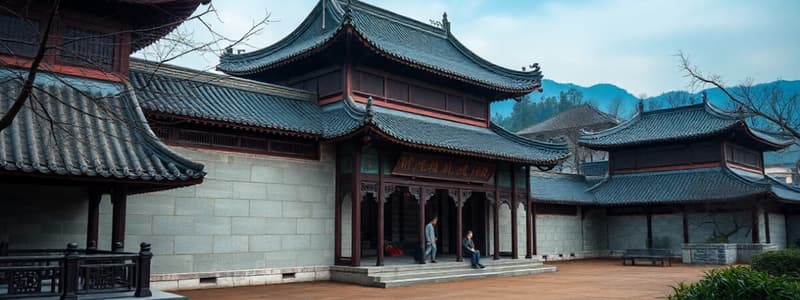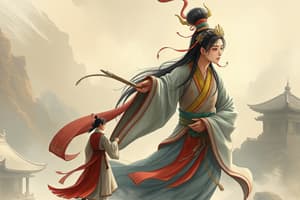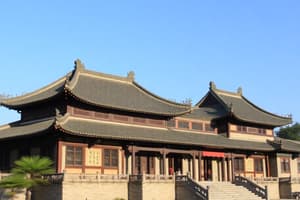Podcast
Questions and Answers
How did the Chinese, under the Song, improve upon a development made during the Tang dynasty?
How did the Chinese, under the Song, improve upon a development made during the Tang dynasty?
- by inventing moveable type (correct)
- by perfecting the magnetic compass
- by perfecting the formula for gunpowder
- by issuing metal coins
During the Song Dynasty Confucianism began to emphasize scientific matters.
During the Song Dynasty Confucianism began to emphasize scientific matters.
False (B)
How did a person become a member of the Chinese civil service starting in the Song dynasty?
How did a person become a member of the Chinese civil service starting in the Song dynasty?
By passing a series of written examinations.
The voyages of Zheng He led to China being seen as a ______ power.
The voyages of Zheng He led to China being seen as a ______ power.
Match the following events with the dynasties they occurred in:
Match the following events with the dynasties they occurred in:
Which of the following rivers is NOT a major river in the Indian Subcontinent?
Which of the following rivers is NOT a major river in the Indian Subcontinent?
The caste system in India is based on a person's achievements and skills.
The caste system in India is based on a person's achievements and skills.
Name the capital city of Bangladesh.
Name the capital city of Bangladesh.
The ______ is the highest mountain in the world, located in the Himalayas.
The ______ is the highest mountain in the world, located in the Himalayas.
Match the following religions with their places of origin:
Match the following religions with their places of origin:
What is the primary role of the monsoons in the Indian Subcontinent?
What is the primary role of the monsoons in the Indian Subcontinent?
The Green Revolution was a program aimed at reducing food production in India.
The Green Revolution was a program aimed at reducing food production in India.
What is the name of a group of people from the mountains of Nepal known for their expertise in high-altitude climbing?
What is the name of a group of people from the mountains of Nepal known for their expertise in high-altitude climbing?
What is the name of the barrier made of walls across China's northern frontier?
What is the name of the barrier made of walls across China's northern frontier?
The ______ is the idea that heaven chose China's ruler and gave him/her the power.
The ______ is the idea that heaven chose China's ruler and gave him/her the power.
The capital of China during the Qin dynasty was Xian.
The capital of China during the Qin dynasty was Xian.
Which of the following is a major river in northern China?
Which of the following is a major river in northern China?
What was the main reason why Chinese civilization began along the Huang He River instead of the Chang Jiang Valley?
What was the main reason why Chinese civilization began along the Huang He River instead of the Chang Jiang Valley?
Which device uses the position of shadows cast by the sun to tell the time of day?
Which device uses the position of shadows cast by the sun to tell the time of day?
The Grand Canal was built during the Song dynasty.
The Grand Canal was built during the Song dynasty.
Match the following terms with their definitions:
Match the following terms with their definitions:
What was the name of the capital city during the Song dynasty?
What was the name of the capital city during the Song dynasty?
What is the name of the major river in China that is also known as the Yangzi River?
What is the name of the major river in China that is also known as the Yangzi River?
The ______ is a network of trade routes that connected China to the Mediterranean Sea.
The ______ is a network of trade routes that connected China to the Mediterranean Sea.
The seismograph is a device used to measure the strength of earthquakes.
The seismograph is a device used to measure the strength of earthquakes.
Match the following inventions or innovations to the Chinese dynasty that is credited with their development:
Match the following inventions or innovations to the Chinese dynasty that is credited with their development:
What significant change did Shi Huangdi bring to China?
What significant change did Shi Huangdi bring to China?
The Han dynasty is known for its expansion and development of a vast system of roads.
The Han dynasty is known for its expansion and development of a vast system of roads.
What is the name of the huge palace complex constructed by Ming emperors in Beijing?
What is the name of the huge palace complex constructed by Ming emperors in Beijing?
Flashcards
Song dynasty advancements
Song dynasty advancements
The Song dynasty improved upon Tang developments by perfecting the magnetic compass.
Confucianism change in Song
Confucianism change in Song
During the Song dynasty, Confucianism began to emphasize scientific matters more than before.
Civil service exam in China
Civil service exam in China
A person could join the Chinese civil service by passing a series of written examinations starting in the Song dynasty.
Mongol rule effects
Mongol rule effects
Signup and view all the flashcards
Zheng He's voyages
Zheng He's voyages
Signup and view all the flashcards
Subcontinent
Subcontinent
Signup and view all the flashcards
Mount Everest
Mount Everest
Signup and view all the flashcards
Ganges River
Ganges River
Signup and view all the flashcards
Monsoons
Monsoons
Signup and view all the flashcards
Hinduism
Hinduism
Signup and view all the flashcards
Caste System
Caste System
Signup and view all the flashcards
Urbanization
Urbanization
Signup and view all the flashcards
Kashmir
Kashmir
Signup and view all the flashcards
East India Company Control
East India Company Control
Signup and view all the flashcards
Partition of India
Partition of India
Signup and view all the flashcards
Hindus and Buddhists
Hindus and Buddhists
Signup and view all the flashcards
Present-Day India
Present-Day India
Signup and view all the flashcards
India's Industrial Expansion
India's Industrial Expansion
Signup and view all the flashcards
Bangladesh vs Bhutan
Bangladesh vs Bhutan
Signup and view all the flashcards
Sri Lanka's Ethnic Conflict
Sri Lanka's Ethnic Conflict
Signup and view all the flashcards
Mandate of Heaven
Mandate of Heaven
Signup and view all the flashcards
Acupuncture
Acupuncture
Signup and view all the flashcards
Silk Road
Silk Road
Signup and view all the flashcards
Gunpowder
Gunpowder
Signup and view all the flashcards
Compass
Compass
Signup and view all the flashcards
Bureaucracy
Bureaucracy
Signup and view all the flashcards
Civil Service
Civil Service
Signup and view all the flashcards
Isolationism
Isolationism
Signup and view all the flashcards
Porcelain
Porcelain
Signup and view all the flashcards
Study Notes
Indian Subcontinent Key Terms
- Subcontinent: A large landmass smaller than a continent
- Mount Everest: Highest mountain in the world, located in India and Nepal
- Ganges River: Major river in northern India
- Delta: Landform at the mouth of a river, formed by sediment deposits
- Indus River: Major river in Pakistan
- Monsoons: Seasonal winds, bringing either dry or moist air
- Delhi: Capital city of the Mughal Empire in northern India
- Colony: Territory controlled by a foreign power
- Partition: Division
- Hinduism: Main religion of India, teaching everything is part of a universal spirit (Brahmin)
- Buddhism: Religion based on Buddha's teachings, originating in India
- Jainism: Indian religion based on Mahavira's teachings, stressing all life is sacred
- Sikhism: Indian religion emphasizing equality, belief in one God, service to humanity, and honest labor
Indian Subcontinent Assessment
- Hindu Kush Mountains: Affected Indian history by slowing/making expensive movement of people and goods, and creating barriers for invaders. Allowing entry for thousands of years.
- Winter Monsoons: Affect India by bringing dry air, cold air, heavy rains, or heavy snowfall.
- Gupta Empire Decline: A series of destructive floods potentially contributed to the Gupta Empire's decline but other factors could also be present.
- East India Company Control: The East India Company controlled India through various methods that included: forcing farmers to provide crops, allowing local leaders to govern, forcing labor in factories, or military force.
- Partition of India: The British government agreed to the partition of India mainly to avoid a larger conflict (civil war), and not to reward allies or establish a Hindu homeland.
- Similarities between Hinduism and Buddhism: Both religions share beliefs in reincarnation and a desire to end personal suffering, however, the idea of social equality might not be universally agreed.
- Present-day India: Most live in villages. Large cities are present, there are modern industries, and although there might be some access to education in many cases it is not universal.
- Harmful Effects of Industrial Expansion: India's industrial expansion has had negative consequences linked with increased air pollution, high unemployment rates, and lower agricultural production.
- Comparison between Bangladesh and Bhutan: The ethnicity of people is a possible element for comparison, with most people in Bangladesh being Muslims and people in Bhutan being Buddhists possibly.
Early Civilizations of China Key Terms
- Chang Jiang (Yangzi River): Major river in China
- Huang He (Yellow River): Major river in northern China
- Mandate of Heaven: Belief that heavenly power chose the Chinese rulers
- Xian: Capital city of China during the Qin dynasty
- Great Wall: A barrier built to protect northern China
- Sundial: Device that uses shadows to tell time
- Seismograph: Measures earthquake strength
- Acupuncture: Practice of inserting needles to cure diseases
- Silk Road: Network of trade routes across Asia, connecting China
- Grand Canal: Canal connecting northern and southern China
- Sui Dynasty: Dynasty during which the Grand Canal was built
- Kaifeng: Capital of China under the Song Dynasty
- Porcelain: Beautiful type of pottery
- Woodblock Printing: Form of printing using carved blocks
- Gunpowder: Mixture of powders used for weapons
- Compass: Tool utilizing Earth's magnetic field to indicate direction
- Bureaucracy: Body of unelected government officials
- Civil Service: Body of people working for the government
- Scholar-Official: Educated member of the Chinese government
- Beijing: Capital of China
- Forbidden City: Palace complex built by Ming emperors of China
- Isolationism: Policy of avoiding contact with other countries
Early Civilizations of China Assessment
- Chinese Civilization Origin: Chinese civilization began along the Huang He (Yellow River) due to the fertile land and favorable conditions for agriculture, particularly for growing cereal crops.
- Shi Huangdi's Changes: Shi Huangdi's main contribution was consolidating power and establishing a unified China.
- Han Dynasty's Impacts: The Han dynasty changed Chinese society by establishing a system of meritocracy to select officials by testing, and building a complex road system.
- Silk Road Impacts: The Silk Road facilitated the spread of various aspects of Chinese culture, impacting other cultures as well. Including the introduction of jade, papermaking, new religions, and even new forms of writing.
- Tang Dynasty Uniqueness: The Tang dynasty was unique for its presence of a female ruler and major advances in science and transportation.
- Song Dynasty Trade Changes: The Song dynasty saw a shift towards increased trade, with China beginning to export silver and welcome traders from other regions.
- Song Dynasty Improvements: The Song dynasty refined existing technologies, like creating an advanced version of the compass and developing gunpowder.
- Confucianism Changes: Confucianism evolved throughout the Song dynasty, becoming associated with the government rather than a spiritual matter.
- Civil Service Selection: Becoming a member of the Chinese civil service began to involve passing written examinations and demonstrating expertise.
- Mongol Rule Impacts: Mongol rule affected China in various ways, resulting in decreased trade with Europe, major changes to the civil service exam system, and improvements to transportation systems.
- Zheng He's Voyages Impact: Zheng He's voyages resulted in new explorations of lands, new trade routes, and increased recognition of China as a major power.
- Censor's role in Ming Dynasty: Censors in the Ming dynasty played a vital role in ensuring that the government was functioning properly and preventing widespread corruption. They assisted Ming emperors by advising on policies, identifying corruption, and suggesting improvements to governance. They also created questions for the necessary civil service exams.
Studying That Suits You
Use AI to generate personalized quizzes and flashcards to suit your learning preferences.




